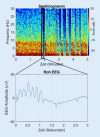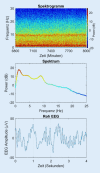[The quantitative EEG in electroencephalogram-based brain monitoring during general anesthesia]
- PMID: 33970302
- PMCID: PMC8108440
- DOI: 10.1007/s00101-021-00960-5
[The quantitative EEG in electroencephalogram-based brain monitoring during general anesthesia]
Abstract
The electroencephalogram (EEG) is increasingly being used in the clinical routine of anesthesia in German-speaking countries. In over 90% of patients the frontal EEG changes somewhat predictably in response to administration of the normally used anesthetic agents (propofol and volatile gasses). An adequate depth of anesthesia and appropriate concentrations of anesthetics in the brain generate mostly frontal oscillations between 8 and 12 Hz as well as slow delta waves between 0.5 and 4 Hz. The frontal EEG channel is well-suited for avoidance of insufficient depth of anesthesia and excessive administration of anesthetics. This article explains the clinical interpretation of the most important EEG patterns and the biophysical background. Also discussed are important limitations and pitfalls for the clinical routine, which the anesthetist should know in order to utilize the EEG as an admittedly incomplete but clinically extremely important parameter for the level of consciousness.
Das Elektroenzephalogramm (EEG) findet im klinischen Alltag der Anästhesie des deutschsprachigen Raumes zunehmend Anwendung. Bei über 90 % der Patienten ändert sich das frontale EEG als Reaktion auf die Gabe der gebräuchlichen Narkotika (Propofol und volatile Narkosegase) in typischer Weise. Eine adäquate Narkosetiefe und angemessene Konzentrationen der Anästhetika im Gehirn erzeugen meist frontale Oszillationen zwischen 8 und 12 Hz (α-Oszillationen) sowie langsame δ‑Wellen zwischen 0,5 und 4 Hz. Die frontale EEG-Ableitung eignet sich gut zur Vermeidung einer unzureichenden Narkosetiefe bzw. einer Überdosierung von Anästhetika. Im Folgenden werden die klinische Interpretation der wichtigsten EEG-Muster und ihr biophysikalischer Hintergrund erläutert. Ebenso werden wichtige Limitationen und „Fallstricke“ für den klinischen Alltag diskutiert, die der Anästhesist kennen sollte, um das EEG als zwar unvollständigen, aber klinisch äußerst wichtigen Parameter des Bewusstseinslevels zu nutzen.
Keywords: Anesthesia, general; Anesthetics, general; Consciousness; Dose-response relationship, drug; Intraoperative neurophysiological monitoring.
References
-
- Gibbs FA, Gibbs EL, Lennox WG. Effect on the electro-encephalogram of certain drugs which influence nervous activity. Arch Intern Med. 1937;60:154–166. doi: 10.1001/archinte.1937.00180010159012. - DOI
MeSH terms
Substances
LinkOut - more resources
Full Text Sources
Other Literature Sources














